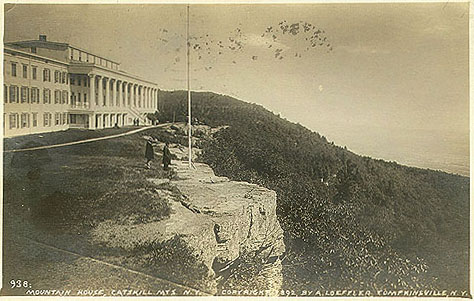
Catskill Mountain House, 1892
"The scene was
disturbingly, hauntingly American, full of pathos and loneliness."
(1958) - Roland Van Zandt
Catskill Mountain House

Catskill Mountain House, 1892
Here
we pay our respects to the most famous ruin to ever grace the Hudson Valley, the
Catskill Mountain House. Abandoned after the 1942 season following decades of
decline, the Mountain House fell into disrepair and ruin brought on by general
neglect. A hurricane in 1950 damaged the famous Corinthian columns of the piazza
overlooking the Hudson River. During the twenty-year period of abandonment, the
Mountain House was deconstructed, as it had been built, in stages. The
crumbling ruin was finally burned to the ground at 6 a.m. on January 25, 1963, by the
New York State Department of Conservation.
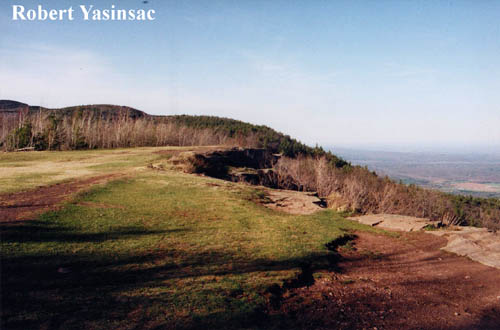
Site of the Catskill Mountain House, April
28, 2003
We won't write much
here - the Catskill Mountain House has been thoroughly documented already. The
Catskill Mountain House, by Roland Van Zandt, tells the tale of
"America's Grandest Hotel," from its beginnings in 1823 to its fiery
demise 140 years later. The empty Mountain House bled with historic and
architectural significance, and commanded a world-famous view. However, like
most other Catskill resorts of the
period, efforts at revitalization failed, interest in the buildings declined,
and conservation departments reclaimed the lands to their "natural"
states. Van Zandt unexpectedly stumbled upon the ruins during a summer hike in
1958. There, encapsulated in the dramatic scene of the great ruins of an
elegant resort, he saw the polarities of American history - city and country,
civilization and wilderness.
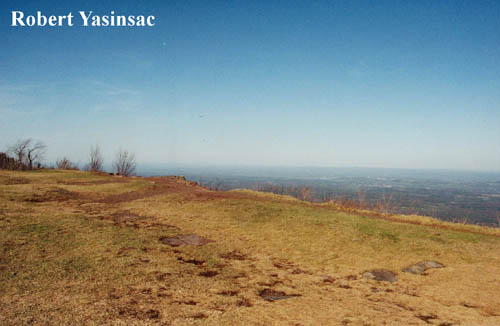
"An awful precipice of graywacke...from
which the view is as awe-inspiring
as it is extensive." - Gazetteer of the State of New York (1824)
Thomas Cole and his kindred spirits
of the Hudson River School noted these polarities in their paintings and
writings, which helped define the American identity. Soon, the Hudson became
comparable to the great rivers of Europe due to the sublime scenery visible from
the Catskill Mountain House. Yet the Hudson River lacked one thing the
great rivers of Europe had plenty of: ruins. Today, there are scores of ruined
or abandoned 19th- and 20th-century sites in the Hudson Valley.
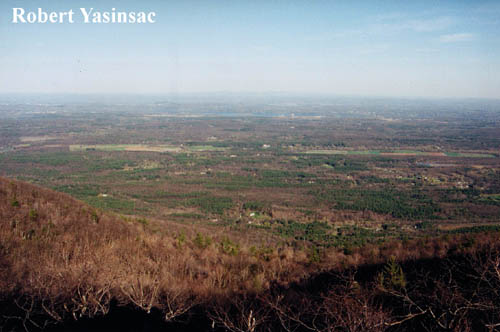
So it was the place the helped spark a body of art and literature uniquely
American would also develop as one of the first great ruins of American society.
Van Zandt's book paints a picture so vivid that one almost expects to see the
Mountain House when entering the clearing near that dangerous precipice. Alas,
not one post, or brick, or crumbled molding piece remains. The site however, is
no less awe-inspiring as it was in the 1820s, but the tourists don't come in
great numbers. We had the place to ourselves one recent beautiful spring
afternoon.
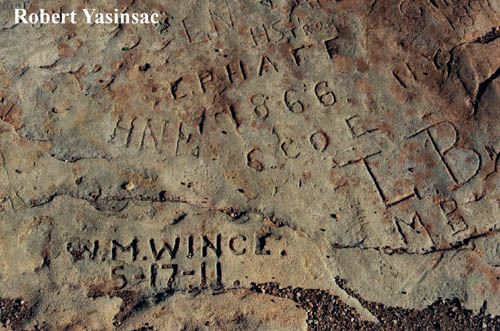
One more polarity for you: I first visited the site of the Catskill Mountain House in the spring of 2003, just one month after visiting some of the famous monuments of the American West. There, in the middle of nowhere, were teeming crowds of tourists. Here, 2 hours from the greatest city in the world, we found nothing but the ghosts of those who came before - etchings in the rock ledge.
Yaz’ Hudson Valley Ruins and Abandoned Buildings, etc.
This page copyright © 2002 by Robert J.Yasinsac. All rights reserved. These images are for private, non-commercial viewing purposes only and cannot be copied or reproduced without permission from Robert Yasinsac. See the porcupine.